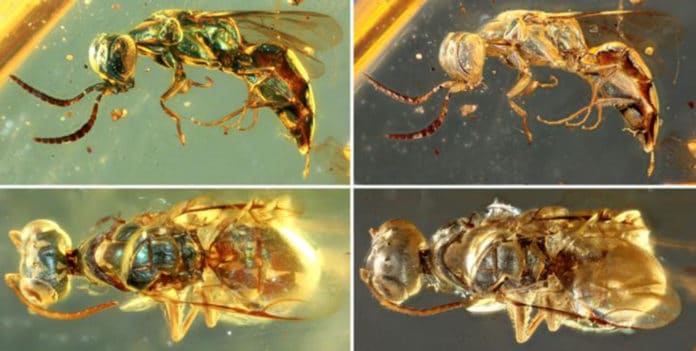Colors offer many clues about the behavior and ecology of animals. They function to keep organisms safe from predators, at the right temperature, or attractive to potential mates. Understanding the coloration of long-extinct animals can help us shed light on ecosystems in the deep geological past.
Scientists from the Nanjing Institute of Geology and Palaeontology of the Chinese Academy of Sciences (NIGPAS) has unlocked the secrets of true coloration in 99-million-year-old insects. This discovery is expected to provide new views on the lives of insects that co-existed alongside dinosaurs in Cretaceous rainforests.
For the study, scientists collected treasure of 35 amber pieces with exquisitely preserved insects from an amber mine in northern Myanmar.

The rare set of amber fossils includes cuckoo wasps with metallic bluish-green, yellowish-green, purplish-blue, or green colors on the head, thorax, abdomen, and legs. In terms of color, they are almost the same as cuckoo wasps that live today.
There were also blue and purple beetle specimens and a metallic dark-green soldier fly.
Prof. Huang Diying from NIGPAS, a co-author of the study, said, “We have seen thousands of amber fossils, but the preservation of color in these specimens is extraordinary.”
Prof. Pan Yanhong from NIGPAS, a specialist on palaeocolor reconstruction, said, “The type of color preserved in the amber fossils is called structural color. It is caused by the microscopic structure of the animal’s surface. The surface nanostructure scatters light of specific wavelengths and produces very intense colors. This mechanism is responsible for many of the colors we know from our everyday lives.”
Scientists wanted to know how and why color is preserved in some amber fossils but not in others. They also wanted to know if the colors seen in fossils are the same as the ones insects paraded more than 99 million years ago.
To find out the answer, scientists used a diamond knife blades to cut through the exoskeleton of two of the colorful amber wasps and a sample of the normal dull cuticle.
They used electron microscopy to show that colorful amber fossils have a well-preserved exoskeleton nanostructure that scatters light. The unaltered nanostructure of colored insects suggested that the colors preserved in amber may be the same as the ones displayed by them in the Cretaceous. But in fossils that do not keep color, the cuticular structures are severely damaged, explaining their brown-black appearance.
Dr. Cai said, “Extant cuckoo wasps are, as their name suggests, parasites that lay their eggs into the nests of unrelated bees and wasps. Structural coloration has been shown to serve as camouflage in insects, and so it is probable that the color of Cretaceous cuckoo wasps represented an adaptation to avoid detection. At the moment, we also cannot rule out the possibility that the colors played other roles besides camouflage, such as thermoregulation.”
Journal Reference:
- Structural colors in diverse Mesozoic insects, Proceedings of the Royal Society B (2020). rspb. DOI: 10.1098/rspb.2020.0301
